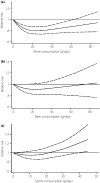Specific types of alcoholic beverage consumption and risk of type 2 diabetes: A systematic review and meta-analysis
- PMID: 27181845
- PMCID: PMC5217901
- DOI: 10.1111/jdi.12537
Specific types of alcoholic beverage consumption and risk of type 2 diabetes: A systematic review and meta-analysis
Abstract
Aims/introduction: Previous meta-analyses identified an inverse association of total alcohol consumption with the risk of type 2 diabetes. The current study further explored the relationship between specific types of alcoholic beverage and the incidence of type 2 diabetes.
Materials and methods: A search of PubMed, Embase and Cochrane Library databases from January 1966 to February 2016 was carried out for prospective cohort studies that assessed the effects of specific types of alcoholic beverage on the risk of type 2 diabetes. The pooled relative risks with 95% confidence interval were calculated using random- or fixed-effect models when appropriate.
Results: A total of 13 prospective studies were included in this meta-analysis, with 397,296 study participants and 20,641 cases of type 2 diabetes. Relative to no or rare alcohol consumption, wine consumption was associated with a significant reduction of the risk of type 2 diabetes, with the pooled relative risks of 0.85, whereas beer or spirits consumption led to a slight trend of decreasing risk of type 2 diabetes (relative risk 0.96, 0.95, respectively). Further dose-response analysis showed a U-shaped relationship between all three alcohol types and type 2 diabetes. Additionally, the peak risk reduction emerged at 20-30 g/day for wine and beer, and at 7-15 g/day for spirits, with a decrease of 20, 9 and 5%, respectively.
Conclusions: Compared with beer or spirits, wine was associated with a more significant decreased risk of type 2 diabetes. The present study showed that wine might be more helpful for protection against type 2 diabetes than beer or spirits.
Keywords: Meta-analysis; Specific alcohol consumption; Type 2 diabetes.
© 2016 The Authors. Journal of Diabetes Investigation published by Asian Association for the Study of Diabetes (AASD) and John Wiley & Sons Australia, Ltd.
Figures






Similar articles
-
Drugs for preventing postoperative nausea and vomiting in adults after general anaesthesia: a network meta-analysis.Cochrane Database Syst Rev. 2020 Oct 19;10(10):CD012859. doi: 10.1002/14651858.CD012859.pub2. Cochrane Database Syst Rev. 2020. PMID: 33075160 Free PMC article.
-
Systemic pharmacological treatments for chronic plaque psoriasis: a network meta-analysis.Cochrane Database Syst Rev. 2021 Apr 19;4(4):CD011535. doi: 10.1002/14651858.CD011535.pub4. Cochrane Database Syst Rev. 2021. Update in: Cochrane Database Syst Rev. 2022 May 23;5:CD011535. doi: 10.1002/14651858.CD011535.pub5. PMID: 33871055 Free PMC article. Updated.
-
Intravenous magnesium sulphate and sotalol for prevention of atrial fibrillation after coronary artery bypass surgery: a systematic review and economic evaluation.Health Technol Assess. 2008 Jun;12(28):iii-iv, ix-95. doi: 10.3310/hta12280. Health Technol Assess. 2008. PMID: 18547499
-
Selenium for preventing cancer.Cochrane Database Syst Rev. 2018 Jan 29;1(1):CD005195. doi: 10.1002/14651858.CD005195.pub4. Cochrane Database Syst Rev. 2018. PMID: 29376219 Free PMC article.
-
Sertindole for schizophrenia.Cochrane Database Syst Rev. 2005 Jul 20;2005(3):CD001715. doi: 10.1002/14651858.CD001715.pub2. Cochrane Database Syst Rev. 2005. PMID: 16034864 Free PMC article.
Cited by
-
Hypertension in Pregnancy Among Immigrant and Swedish Women: A Cohort Study of All Pregnant Women in Sweden.J Am Heart Assoc. 2024 Mar 5;13(5):e031125. doi: 10.1161/JAHA.123.031125. Epub 2024 Feb 16. J Am Heart Assoc. 2024. PMID: 38366326 Free PMC article.
-
The Dose-Response Relationship between Alcohol Consumption and the Risk of Type 2 Diabetes among Asian Men: A Systematic Review and Meta-Analysis of Prospective Cohort Studies.J Diabetes Res. 2020 Aug 24;2020:1032049. doi: 10.1155/2020/1032049. eCollection 2020. J Diabetes Res. 2020. PMID: 32908932 Free PMC article.
-
Consumption of Alcoholic Beverages and the Prevalence of Metabolic Syndrome and Its Components.Nutrients. 2019 Nov 14;11(11):2764. doi: 10.3390/nu11112764. Nutrients. 2019. PMID: 31739490 Free PMC article.
-
Alcohol consumption and incidence of proteinuria: a retrospective cohort study.Clin Exp Nephrol. 2018 Oct;22(5):1133-1142. doi: 10.1007/s10157-018-1568-0. Epub 2018 Mar 29. Clin Exp Nephrol. 2018. PMID: 29600409
-
The obesity epidemic and rising diabetes incidence in a low-income racially diverse southern US cohort.PLoS One. 2018 Jan 11;13(1):e0190993. doi: 10.1371/journal.pone.0190993. eCollection 2018. PLoS One. 2018. PMID: 29324894 Free PMC article.
References
-
- Zhang P, Zhang X, Brown J, et al Global healthcare expenditure on diabetes for 2010 and 2030. Diabetes Res Clin Pract 2010; 87: 293–301. - PubMed
-
- Chen L, Magliano DJ, Zimmet PZ. The worldwide epidemiology of type 2 diabetes mellitus–present and future perspectives. Nat Rev Endocrinol 2012; 8: 228–236. - PubMed
-
- Zimmet P, Alberti KG, Shaw J. Global and societal implications of the diabetes epidemic. Nature 2001; 414: 782–787. - PubMed
Publication types
MeSH terms
LinkOut - more resources
Full Text Sources
Other Literature Sources
Medical
Molecular Biology Databases

